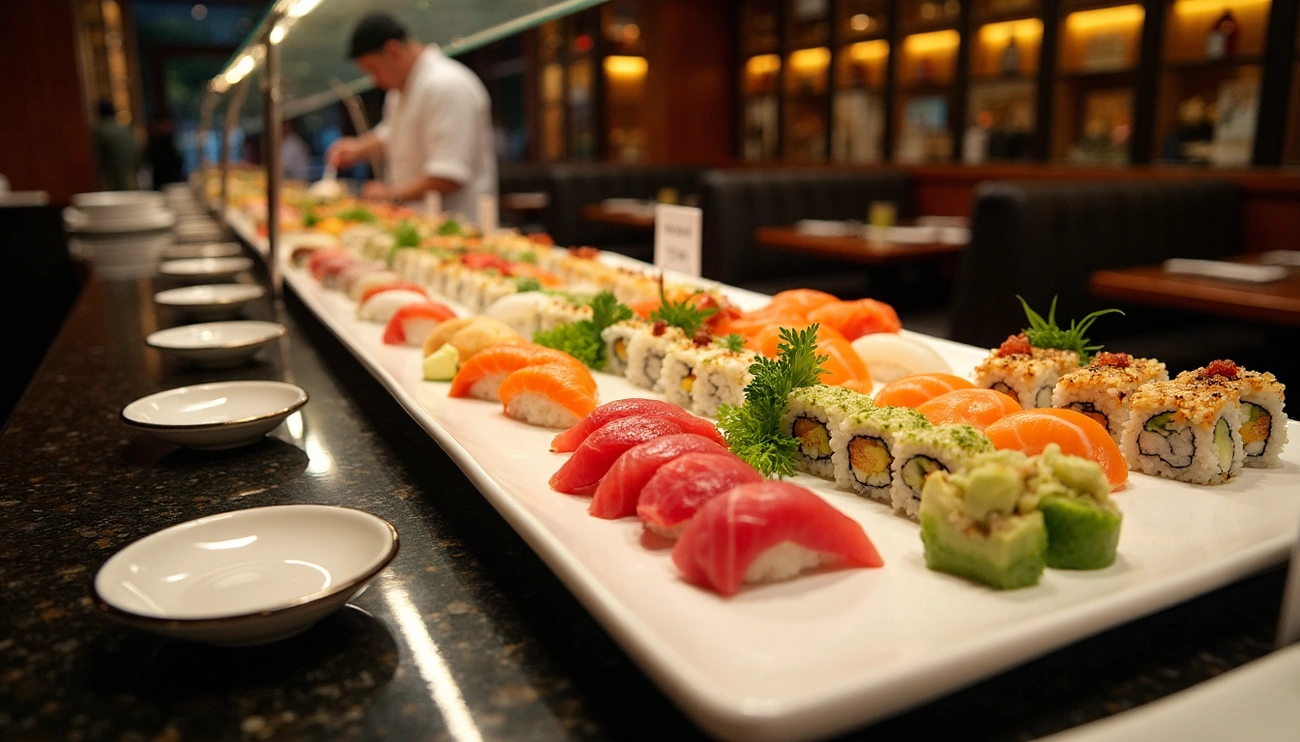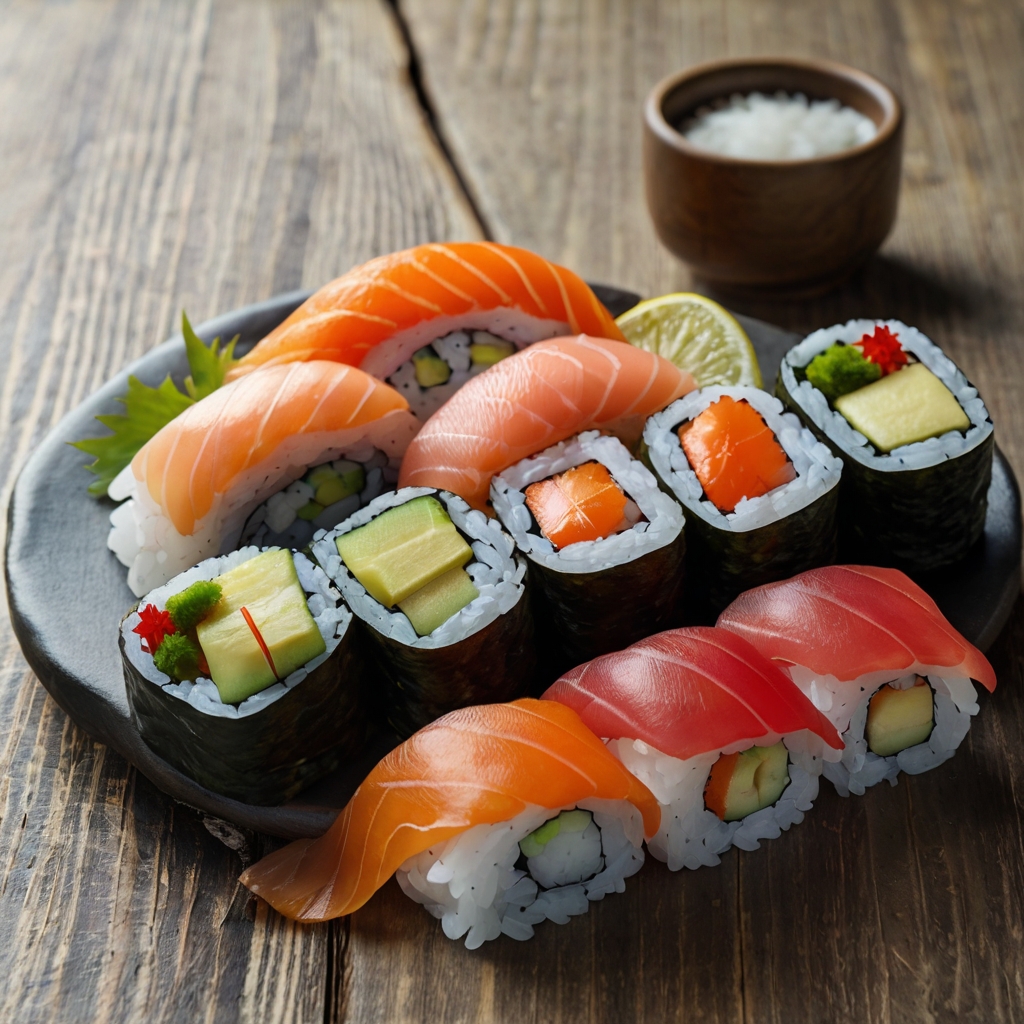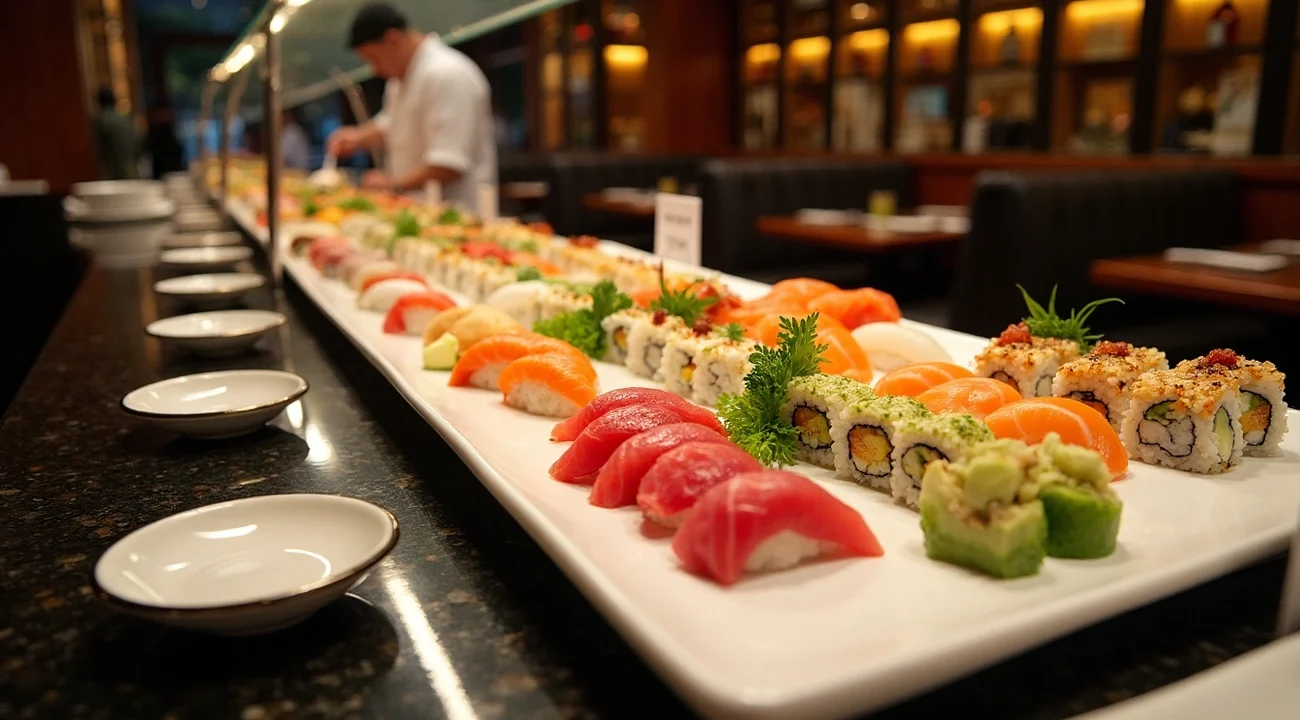All You Can Eat Sushi
All You Can Eat Sushi restaurants serve affordable meals that cost as little as $7.99 per person daily. Regular sushi establishments charge around $9 for just one and a half to two maki rolls, making this price point quite a bargain.
The best all you can eat sushi spots deserve a closer look before you head out. Places like The Fishhouse, Kai Lana Sushi, and Hibachi Buffet in Louisville give you choices from traditional hibachi grills to extensive sushi buffet lines. The idea of unlimited sushi that costs less than à la carte dining sounds amazing, and these places have a lot to offer. This piece walks you through what to expect, ways to get the most value, and important things to know when you visit all you can eat sushi restaurants in popular spots like Las Vegas, Chicago, Austin, Orlando, and San Diego.

What You Expect When You Hear ‘All You Can Eat Sushi’
Fixed-price unlimited sushi creates instant appeal for food lovers nationwide. Diners from Las Vegas to Orlando, Chicago to San Diego have embraced this all-you-can-eat trend that combines value with variety.
The appeal of unlimited sushi
All-you-can-eat sushi’s attraction goes way beyond the reach of simple economics. These restaurants are a great way to get a taste of Japanese cuisine without worrying about your wallet. Customers can try many different rolls at a single flat fee—usually $20 to $50 per person, instead of limiting themselves to one or two rolls.
This setup works great for people who love trying new foods. Diners can explore different flavors without spending full price on dishes they might not like. The AYCE model also creates perfect conditions for group dining, which makes these spots ideal for family gatherings and special events.
Each restaurant handles service differently. Some use traditional paper menus where guests check off their choices, while others have switched to digital tablet systems that make ordering easier. Some high-end spots keep the classic sushi bar setup where chefs make rolls right in front of you—no buffet lines anywhere.
Common assumptions about quality and variety
“All you can eat sushi” brings specific thoughts off the top of my head. Most people think these places trade quality for quantity. This idea comes from comparing AYCE spots to traditional sushi restaurants that make everything fresh to order.
Diners usually expect:
- Lots of roll options, but fewer premium choices
- Fresh ingredients, though maybe not top-grade
- Smaller portions with more rice than fish
- A laid-back vibe unlike upscale sushi spots
People often think buffet-style sushi always has quality issues. All the same, each place is different. Most assume the sushi sits out under heat lamps or in cold cases for hours, but premium spots like Kingdom Sushi in Orlando make everything fresh after you order.
People also have misconceptions about ingredients. While many think these places use lower-quality fish across the board, some restaurants take pride in their ingredient quality. The appeal of unlimited sushi depends on finding the sweet spot between value and quality—customers accept certain compromises to sample more varieties.
Sushi experts approach these restaurants carefully, knowing that traditional sushi requires years of training. Getting the title of Itamae (Sushi Master) takes 10 years of apprenticeship. This traditional approach clashes with what people expect from all-you-can-eat venues, creating tension between authenticity and accessibility that shapes customer expectations before their first bite.
The Reality Behind the Buffet Line
The colorful display of maki rolls and nigiri at all-you-can-eat sushi restaurants hides a reality that’s quite different from what most diners might expect. These insights will change the way you look at your unlimited sushi experience.
Why not all rolls are created equal
The gap in quality between traditional sushi bars and all-you-can-eat spots comes down to how they source and prepare ingredients. Buffet-style venues often use basic ingredients that aren’t as premium as dedicated sushi restaurants. These places need to keep their profits up, so they opt for lower-grade fish and ingredients, which affects how the sushi tastes and feels.
This quality difference shows up in several ways:
- The staff isn’t as experienced and focuses on speed over artistry
- You’ll find fewer options, mostly common sushi types
- Rolls come loaded with sauces and toppings to mask lower-quality fish
Some upscale buffets hide their best ingredients like truffles, foie gras, and oysters where diners can’t easily find them. The way they prepare sushi is also quite different. Traditional sushi chefs (Itamae) spend years mastering their craft, while AYCE venues care more about quantity than quality.
How freshness can vary throughout the day
The time of day plays a vital role in sushi quality at buffet places. Raw fish can grow bacteria at room temperature—this is a big deal in buffet settings. Even the rice can be risky and might harbor Bacillus cereus bacteria if it sits out too long.
Here’s what to watch for freshness:
A busy restaurant is a good sign—they replace sushi more often. You’ll get fresher options during rush hours than slow periods when turnover drops. The best places make sushi to order or keep restocking throughout service.
Places where you can see chefs working behind counters or glass walls tend to maintain better standards than those with hidden kitchens.
The role of rice in filling you up fast
Rice might be the smartest part of all-you-can-eat sushi strategy. Restaurants think over where they put starchy foods like rice. They know 75% of customers grab what’s first in line—and 66% of all food eaten comes from the first three trays.
Rice works as a cheap filler that makes diners feel full quickly. When you eat carb-rich foods like rice, they turn into glucose, making you feel good while filling up your stomach. That’s why many people feel stuffed after just a few rolls.
Smart AYCE sushi fans start with sashimi (pure fish without rice) to get their money’s worth. The ratio of fish to rice matters—experts say you should aim for 3 parts fish to 1 part rice. Many buffets serve rolls with equal parts fish and rice, or sometimes more rice than fish.
These behind-the-scenes insights will help you get the most out of your all-you-can-eat sushi experience, whether you’re in Las Vegas, Chicago, or Orlando. It’s not about eating more—it’s about making smart choices for better value and enjoyment.
What Restaurants Don’t Tell You
AYCE sushi restaurants follow unspoken rules and restrictions that protect their profits. These hidden policies can affect your dining experience by a lot and determine how much value you get from your meal.
Time limits and hidden rules
Most restaurants limit your dining time to 60-90 minutes, despite advertising “all you can eat.” Your time starts when you sit down. Tourist hotspots in Las Vegas and Orlando enforce these limits strictly when they’re busy.
There’s another reason why you can’t order everything at once – restaurants limit you to 2-3 rolls per round. This helps prevent kitchen backups and slows down how much you eat. You can’t share food with people who haven’t paid, and some places will charge full price if they catch you doing it.
Extra charges for leftovers or waste
First-time AYCE sushi customers might be surprised by food waste penalties. You’ll pay $1-3 for each piece of uneaten sushi left on your plate. These charges discourage people from ordering more than they can eat.
Different cities handle these rules differently:
- San Diego and Chicago restaurants weigh leftover food and charge based on weight
- Austin places tend to be more relaxed and give warnings first
- Las Vegas buffets have the toughest penalties and charge extra for uneaten specialty items
Smart diners start with small orders and add more as needed to avoid these fees. This careful approach doesn’t match the unlimited experience these restaurants advertise.
Limited premium options on the menu
Look closely at AYCE menus and you’ll find that not everything comes with the base price. You’ll pay extra for premium ingredients like fatty tuna (toro), uni (sea urchin), and real crab.
Some places offer different price tiers, charging $10-20 more to access premium AYCE options. The best quality fish stays on the à la carte menu. This creates an illusion of unlimited choices while restaurants keep their expensive ingredients profitable.
How some items are made to slow you down
Restaurants design their menus to fill you up quickly. They give you free items like miso soup, edamame, and green salad when you start. These cheap appetizers take up space in your stomach.
The kitchen times your food delivery strategically. Cheaper items arrive first, while premium selections come later. Most people feel full by the time expensive fish arrives. Every part of your dining experience – from menu design to service patterns – has been arranged to control how much you eat while making you feel like you have unlimited options.

How to Get the Most Out of Your Visit
Becoming skilled at all-you-can-eat sushi needs smart planning and insider tips. Smart diners hit these places with a game plan to get the best value and quality picks. Here are some expert tips to make your next AYCE sushi trip a soaring win.
Start with high-value items
The best items have more fish than rice. You should aim for a 3-to-1 fish-to-rice ratio to get the most value. Sashimi makes a great starting point when it’s on the menu. These pure fish cuts come without rice and leave room for more food. The specialty rolls that usually cost $14.95 or more give you amazing value in an AYCE setting. Seasoned diners suggest starting with 5-6 pieces of nigiri in your first round before moving to maki rolls.
Avoid filler foods early on
Restaurants often put out appetizers like edamame, miso soup, and small salads that fill you up quickly. These items might look good at first, but they cut down how much you can eat by a lot. One expert points out, “Things like edamame and miso soup are fine… but you’re asking for it if you start with things like gyoza or baked green mussels”. Skip deep-fried or cream cheese-filled options at the start—these heavy items will slow you down fast.
Pace yourself and plan your order
Smart pacing leads to AYCE sushi success. We ordered in multiple rounds instead of getting too much food at once. A good approach starts with a small first round to test your appetite, then ramps up in the second round. The timing of your visit matters too—eating between 2-4pm usually means faster service and fresher food. Make sure you have enough time—most places give you 60-90 minutes, so quick ordering is vital.
Ask about made-to-order options
Quality AYCE sushi spots make items fresh when you order, unlike regular buffets. Fresh-made options taste better and feel fresher than pre-made ones. Look for places where you can see chefs working at sushi counters. Restaurants that advertise “handcrafted” rolls usually serve better food than standard buffet operations. Don’t hesitate to ask your server about fresh-made options—their answer will help you pick the best strategy for that spot.
Regional Differences in AYCE Sushi
Learning about AYCE sushi in U.S. cities shows how prices, special items, and dining experiences change from one place to another. The digital world of unlimited sushi looks different based on your location, and each city adds its own flavor to the all-you-can-eat concept.
All you can eat sushi in Las Vegas vs. Chicago
Las Vegas reigns supreme as the ultimate destination for all-you-can-eat sushi. The city’s competitive dining scene creates a paradise for sushi lovers. True to Vegas style, most places offer different price tiers. Lunch specials range from $25.95 to $28.95, while dinner costs between $29.95 and $36.95. Premium options with higher-grade fish and sashimi cost around $44.95.
Vegas stands out with its themed AYCE spots. Guests can enjoy their sushi under cherry blossoms at Sakana or surrounded by anime artwork at Mr.Shota. Several Vegas spots like 888 Japanese BBQ give diners a chance to mix unlimited sushi with tableside grilling, creating an experience you won’t find anywhere else.
Chicago takes a different path with its AYCE sushi scene. The Windy City’s restaurants focus on food quality instead of fancy decorations or entertainment.
What to expect in Austin, Orlando, and San Diego
Austin’s latest AYCE player, Kan Sushi, shows the city’s straightforward take on unlimited sushi. Prices are simple: $26.95 for lunch and $38.95 for dinner. Premium upgrades cost an extra $20.
San Diego’s AYCE scene features restaurants of all types and price points across different neighborhoods. Popular spots include Itacho Sushi in Kearny Mesa, Yummy Sushi in Coronado, and Sushi Roll Land in Hillcrest. The city’s easy access to fresh seafood raises quality expectations, which affects both prices and menu options.
Best all you can eat sushi near me: how to find it
Finding great AYCE sushi spots needs more than just location-based searches. Yelp gives basic details but often misses new restaurants or special pricing deals.
The best search strategy combines these steps:
- Read recent reviews that mention freshness and selection
- Check the restaurant’s social media for current prices and deals
- Call the restaurant directly to ask about made-to-order options
Smart timing is key to a better experience. Many places serve their freshest selections right after opening or during weekday lunch hours when high customer turnover keeps everything fresh.
Summing all up
All-you-can-eat sushi creates an interesting balance between value and compromise. These establishments make Japanese cuisine available without the high costs of traditional sushi restaurants. Savvy diners have figured out the hidden mechanics behind those tempting flat-rate prices.
Behind those colorful displays lie calculated limitations that protect profit margins. The restaurants use time restrictions, waste penalties, and rice-heavy preparations to control how much people eat while creating an illusion of endless abundance. The quality difference between premium à la carte establishments and AYCE venues remains most important, though not universal.
Smart diners tackle these experiences with tactical precision. Starting with high-value items like sashimi or specialty nigiri gives you the best value. You should skip early filler foods like edamame or miso soup to save stomach space. Small, multiple orders work better than large original selections.
Each region puts its own spin on the experience. Las Vegas spots offer theatrical experiences with tiered pricing, while Chicago’s places emphasize traditional quality. Austin, Orlando, and San Diego each bring unique local touches to the AYCE concept.
Next time you look up “best all-you-can-eat sushi near me,” look beyond the advertised price to find true value. These restaurants won’t advertise their limitations openly, but educated customers can still enjoy a great meal by understanding the unspoken rules. The perfect AYCE sushi experience blends smart dining with genuine food appreciation—finding value while respecting this beloved culinary tradition.
Here are some FAQs about all you can eat sushi:
How does all you can eat sushi work?
At all you can eat sushi restaurants, you typically pay a fixed price for unlimited sushi within a set time limit (usually 90-120 minutes). Most all you can eat sushi near me locations provide paper menus where you check off rolls and nigiri in rounds, with some limiting how many premium items you can order per round. The sushi all you can eat model helps restaurants control costs while giving customers variety and value.
How does a sushi train restaurant work?
Sushi train (kaiten-zushi) restaurants feature conveyor belts carrying plates of sushi past diners, different from traditional all you can eat sushi setups. At sushi all you can eat train restaurants, you grab plates as they pass by or order special items directly from chefs. Prices are usually determined by plate color/design, unlike fixed-price all you can eat sushi las vegas buffets where you pay one amount upfront.
How do Japanese buffets work?
Japanese buffets combine elements of all you can eat sushi and cooked dishes in a self-service format, distinct from sushi train operations. Many all you can eat sushi and bbq spots let you grill meats tableside while also offering unlimited sushi selections. These hybrid models are popular in cities like Las Vegas where all you can eat sushi las vegas venues often feature extensive hot food stations alongside raw fish options.
Are you supposed to tip at all you can eat sushi?
Yes, tipping 15-20% is standard at all you can eat sushi restaurants since servers still provide drinks, clear plates, and handle special requests. Even at sushi all you can eat buffets where you serve yourself, staff maintain the dining area and refresh food stations. The tip should reflect the original bill amount before any discounts at all you can eat sushi near me locations.
How much is yo sushi all you can eat?
Yo! Sushi’s all you can eat sushi pricing varies by location but typically ranges $25-$35 per person for lunch and $30-$45 for dinner. Unlike traditional all you can eat sushi and bbq combos, Yo! Sushi focuses solely on Japanese fare with time-limited dining periods. Their sushi all you can eat menu includes unlimited nigiri, rolls, and appetizers during your seating.
What would happen if I ate sushi every day?
Eating all you can eat sushi daily could lead to mercury exposure from frequent fish consumption and potential iodine overload from seaweed. While sushi all you can eat provides lean protein and omega-3s, daily raw fish may increase foodborne illness risk. Moderation is key – occasional all you can eat sushi las vegas splurges are safer than making it an everyday habit.



